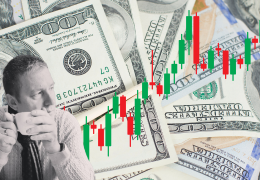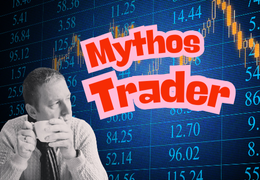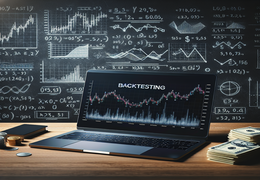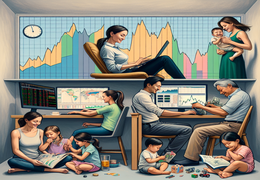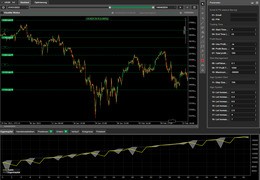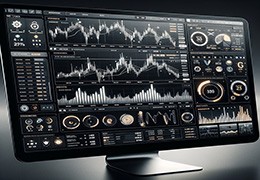Between reality and illusion If you want to know what trading really means—beyond luxury cars, piles of cash, and...
History of day trading
History of day trading
The journey of day trading from its humble beginnings in the era of Distance selling to its current form is a history of Innovation, adaptability and the unstoppable advance of Technology. This development not only reflects the change in the nature and way securities are traded, but also marks a paradigmatic shift in the accessibility of financial markets for the Average citizen.
From telegraphs to global networks
The evolution of day trading from its historical roots, shaped through the use of the telegraph, to today's globally networked trading ecosystem, is a fascinating journey through time. This Development illustrates not only technological progress, but also the increasing democratization of access to financial markets. While the Days of the telegraph an era of restriction and privileged access The deregulation of broker commissions marked a turning point towards a more open and inclusive trading environment.
The path to inclusivity
The loosening of regulatory constraints in the 1970s, which Allowing brokers to offer competitive fees was a critical Moment that laid the foundation for modern commerce. This change broke the traditional barriers that surrounded the financial market and paved the way for a new era of participation. Suddenly the financial market was no longer seen as an exclusive domain for the elite, but began to become a to a wider audience.
Technology as a catalyst for change
The subsequent technological revolution, in particular the introduction of the Internet and electronic trading systems, transformed the Day trading from scratch. These technological breakthroughs enabled the Investors to access real-time market data and make trading decisions from anywhere in the world. The introduction of online trading platforms further democratized access to financial markets and opened up countless Opportunities for individual traders.
The challenge of cybersecurity
With the advent of global networks and online commerce, the Cyber security has become a key concern. The integrity of Commercial transactions and the protection of sensitive data have become critical Aspects that require ongoing investment in security technologies and protocols. The financial industry had to develop innovative Develop solutions to ensure the security of the systems and the To maintain investor confidence.
Globalization and market integration
Parallel to technological development, globalization promoted the Integration of financial markets. The removal of trade barriers and the creation uniform regulatory standards led to an unprecedented Interconnection of global markets. This integrated market landscape enables it is now possible for day traders to benefit from market movements not only in their home country, but all over the world.
An unstoppable march into the future
From the first telegraph lines to today's highly developed global trading networks, day trading has a remarkable Transformation. This development history is not only a Testimony to human ingenuity and the pursuit of financial freedom, but also a glimpse into a future in which the Trade increasingly depends on advanced technologies, global integration and will be characterized by the continuous pursuit of security and transparency. The journey of day trading is far from over and the next phase promises to be just as exciting as the previous ones Developments.
Technological change
The digital revolution that took place in the 1980s and 1990s marked a turning point that changed the landscape of financial trading This transition to digital trading platforms and Electronic Communications Networks (ECNs) ushered in an era in which Information and transactions with unprecedented speed and efficiency This period not only symbolizes a technological revolution, but also a cultural shift in the way Way in which financial markets operate and how participants interact.
The influence on trading strategies
The introduction of electronic commerce opened up completely new dimensions for trading strategies. Algorithms and automated trading systems began gain importance by offering the ability to access market data in real time and make trading decisions based on them. These new tools enabled traders to react to market movements, before they were perceived by the majority of market participants, and offered thus a decisive advantage in an increasingly competitive Environment.
Reduction of barriers and Democratization of access
One of the most significant contributions of electronic commerce has been the Democratization of access to financial markets. By reducing the need for a physical presence was eliminated, traders from all over the world could now world, regardless of their geographical location. This open access not only promoted diversity among market participants, but also increased also the volume and liquidity on the markets.
The role of infrastructure and innovation
With the spread of electronic commerce, the importance of a robust and secure infrastructure. The development of high-performance networks and security protocols crucial to ensure the integrity of commercial transactions and the protection sensitive information. At the same time, this promoted technological evolution a culture of innovation in which new Finding ways to improve the efficiency and effectiveness of trade.
Globalization and market connectivity
The technological revolution contributed significantly to the globalization of financial markets. Electronic trading platforms enabled seamless Integration of different markets and created a networked ecosystem in where information and capital flows know no boundaries. This increased However, connectivity also brought new challenges, such as the Need to harmonize global regulatory standards and to effectively monitor cross-border transactions.
An ongoing evolution
The transition to electronic commerce represents a milestone in the History of day trading, which laid the foundations for today’s high-tech and networked trading world. This technological shift was not only a leap forward in terms of efficiency and accessibility, but also a catalyst for continuous innovation and adaptation in a constantly changing market environment. The digital revolution in financial trading is a living example of how technological progress is changing the way transform the way we think, operate and engage in the markets.
The Internet age and the Democratization of trade
The Internet age not only ushered in a technological revolution, but also fundamentally changed the landscape of day trading. With the Spread of the Internet and the development of advanced Trading platforms in the late 1990s and early 2000s, we experienced a democratization of trade that was previously unimaginable. This period represented a turning point that transformed the financial market from a fortress-like Institution dominated by the financial elites into an open field where anyone with an internet connection could participate.
Access to information
The decisive change that the Internet age brought with it, was the way in which information was distributed and consumed. Market data, financial news and analysis tools that used to be kept behind the doors of Investment banks and institutional trading floors were closed, now available to everyone. This transparency paved the way for a informed generation of traders who were able to make data-driven make decisions and develop their trading strategies based on the same information that was previously only available to a select group were available.
Trading platforms and tools
In addition to access to information, the development of user-friendly trading platforms are another catalyst for the Expansion of day trading. These platforms not only offered the opportunity trades with a few mouse clicks, but also integrated complex Analysis tools that allowed users to perform technical analyses and adapt their strategies in real time. These tools democratized the Trading strategy development, once the domain of professional traders was.
Social networks and Community building
Another significant aspect of this era was the role of social networks and online communities in the trading world. Forums, discussion groups and later social media platforms enabled traders to share knowledge, to discuss strategies and learn from the experiences of others. These Communities formed the basis for a collective intelligence that helped individual traders to develop further and better respond to the react to market volatility.
The challenges of the new freedom
Although the Internet age undeniably opened many doors, it also brought also brought with it new challenges. The flood of information could be overwhelming and the distinction between reliable data and misinformation became a critical skill. In addition, easier accessibility led to The market experienced increased volatility as more traders were willing to to react to short-term movements.
An unstoppable progress
The late 1990s and early 2000s marked the beginning of an era in which day trading is made possible by the Internet and advanced trading platforms were made accessible to the general public. This period of democratization of trade was marked by an unprecedented Access to information, community development and the creation new tools and technologies that gave power to individual traders. Despite the challenges this freedom brought with it, the positive change she brought to the world of day trading, undeniable and continues the way for future innovations.
Regulatory challenges and Adjustments
The dynamic world of day trading, with its rapid development and enormous profit opportunities, has equally the need for careful and thoughtful regulation highlighted. While day trading has become an accessible and popular instrument for many investors, the increasing participation individual traders in the market also face a number of risks and Challenges. The regulatory framework had to adapt to ensure investor protection and while maintaining the integrity and stability of financial markets.
Proactive measures for a safe trade
The implementation of the "Pattern Day Trader" rule by the Financial Industry Regulatory Authority (FINRA) in the USA serves as A prime example of the proactive efforts of regulators to trading with borrowed capital, known as margin trading. This Specific regulation requires traders who have been trading for five Execute four or more day trades per business day, a minimum account balance This serves as a safety net that protects investors from the potentially high risks of margin trading and at the same time ensures that they have sufficient resources to cover possible losses cover up.
Global regulatory efforts
While the "Pattern Day Trader" rule provides a specific example from the United States, similar regulatory initiatives reflect reflects the common goal of making the trade process more transparent and The challenge for regulators worldwide is to find a balance between enabling innovative trading practices and protecting investors from the inevitable Risks associated with day trading.
Strengthening investor confidence
The importance of these regulatory adjustments cannot be overemphasized They not only serve to directly protect investors, but are also essential for maintaining a fair and orderly trading environment that strengthens investor confidence in the markets. In an era where transparency and fairness are increasingly demanded, Such regulatory frameworks are crucial for promoting a healthy financial market.
The balance between innovation and Security
The regulatory challenges and adjustments in the area of Day trading underlines the need for continuous monitoring and adjustment of regulatory policy. While day trading offers opportunities for individual investors to actively participate in the financial market, it is It is essential that regulators remain vigilant and take action to minimize risk and ensure a safe trading environment The future development of day trading will undoubtedly continue a careful balance between promoting innovation and Ensuring the safety and protection of all market participants.
Looking to the future: AI and algorithmic trading
Let us consider the horizon of the Day trading is an exciting, albeit challenging, Vision of the future: The advance into the age of artificial intelligence (AI) and algorithmic trading. These technological advances are the threshold, the way we interpret markets, Make trading decisions and ultimately our financial destiny shape, radically change. For us traders and observers of Wall Street This is not only a technical evolution, but a revolution of strategic thinking.
AI and algorithmic trading: A new era begins
Imagine being able to analyze complex market data within milliseconds analyze to identify patterns that are not visible to the human eye unattainable, and to make precise trading decisions on this basis This is the world of algorithmic trading, enhanced by the unlimited possibilities of artificial intelligence. These technologies are not just tools; they are the new players at the table, equipped with the ability to learn and act at a pace that is far ahead of our human capabilities.
The democratization of trade
One of the most captivating aspects of AI in day trading is its potential Role in the democratization of trade. Through the accessibility of advanced analysis tools that were once exclusively available to institutional investors new horizons are opening up for retailers. This level of resources and information could change the rules of the game by enables individual traders to compete on a par with the big compete.
The challenge: responsibility and integrity
With great power comes great responsibility. The challenge for us in financial sector is to use AI and algorithmic trading in such a way that They not only improve our trading strategies, but also the integrity of the markets. The question of ethics in AI is not trivial; concerns the transparency of our trading decisions and trust in the financial system as a whole.
A connected global market
The future of day trading with AI and algorithms points to a increasingly interconnected global market in which information is transmitted in real time flow and decisions are made faster than ever before. This Networking promises to increase efficiency and the possibility of global Anticipate market trends with unprecedented accuracy.
An exciting but uncertain journey
As a trader and Wall Street journalist, I am on the front line of this technological revolution and watch with excitement as it unfolds. The prospect that AI and algorithmic trading will improve the efficiency and effectiveness of our trading strategies is undoubtedly exciting. But it requires also a reassessment of what it means to be an informed and to be a responsible participant in the financial market.
In this new era of day trading, it is crucial that we do not only focus on technological development, but also on the ethical and regulatory frameworks that ensure that the Progress benefits everyone and not just a select elite. The journey into the future of day trading with AI and algorithmic trading is both promising and uncertain. But one thing is certain: it will irreversibly change the landscape of trade.
The unstoppable evolution of Day trading
Opportunities as well as challenging obstacles. What was once the activity of a small group of market participants has become a widespread practice, brought about by the digital revolution and the globalisation of financial markets received enormous growth. This transformation of day trading underlines not only the influence of technology and regulation on the world of trade, but also the changed perception and acceptance of day trading in the Company.
Expanding access and the role of education
A crucial aspect in the evolution of day trading is the expanded accessibility for a wider audience. The Internet and mobile Technologies have opened the gates to the financial markets, making day trading an option for people who live outside the traditional financial institutions. In parallel, the availability of Online educational resources, webinars and virtual trading simulators interested parties to acquire the necessary knowledge and skills to trade successfully. These educational initiatives have the Day trading from a mysterious or risky venture to a accessible and understood investment strategy.
Innovations in trading technology
The further development of trading platforms and algorithms has Day trading fundamentally changed. Artificial intelligence and machine Learning offers new ways of analyzing markets and making decisions, while advanced trading algorithms make it possible to implement strategies with a To achieve precision and speed that cannot be achieved manually. These technological advances not only increase the efficiency of trade, but also open up new perspectives and strategies that were previously unimaginable were.
The importance of ethical and sustainable Trading practices
As day trading grows, so does the need for ethical standards and promote sustainable trading practices. The community of Day traders are increasingly required to maintain transparency, act responsibly and contribute to the integrity of financial markets. These aspects are crucial to strengthening trust between market participants and ensuring positive perception of day trading among the wider public support financially.
Global perspectives and the future of Day trading
The future of day trading looks promising, with a steady Increase in global interconnectedness and the development of new financial instruments. The ongoing integration of financial markets worldwide offers day traders countless opportunities, but it also brings with it complex challenges, particularly with regard to regulatory compliance and Market volatility. The ability to adapt to changing market conditions and using innovative technologies will continue to play a key role to succeed in this dynamic environment.
The unstoppable evolution of day trading reflects the ongoing adaptability and willingness to innovate of the financial community. While the practice of day trading continues to evolve, the pursuit for knowledge, ethical action and the use of technological advances central to being successful in the world of modern financial trading.

